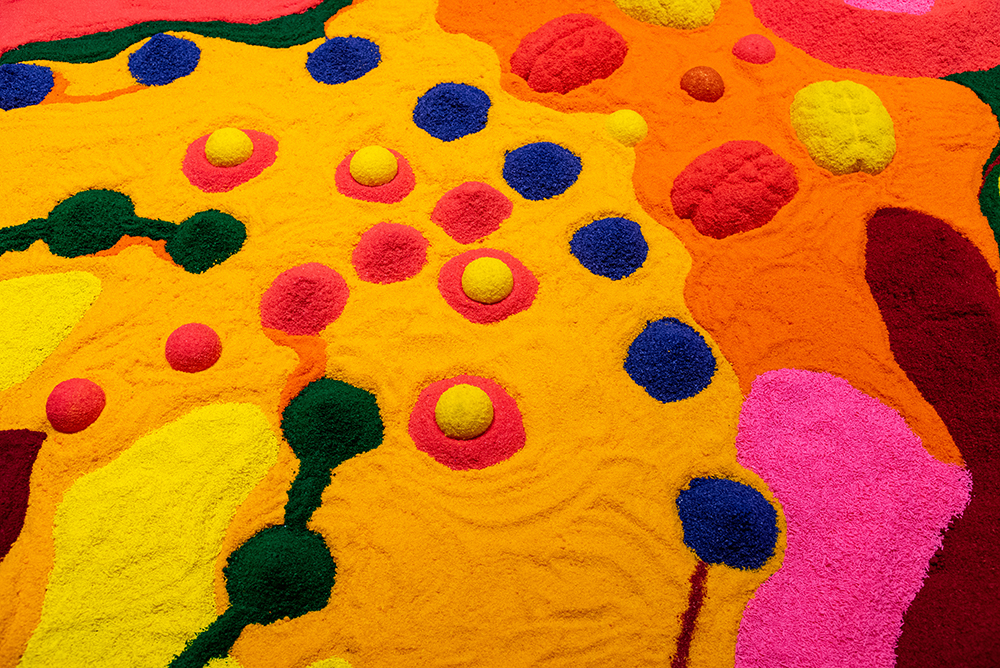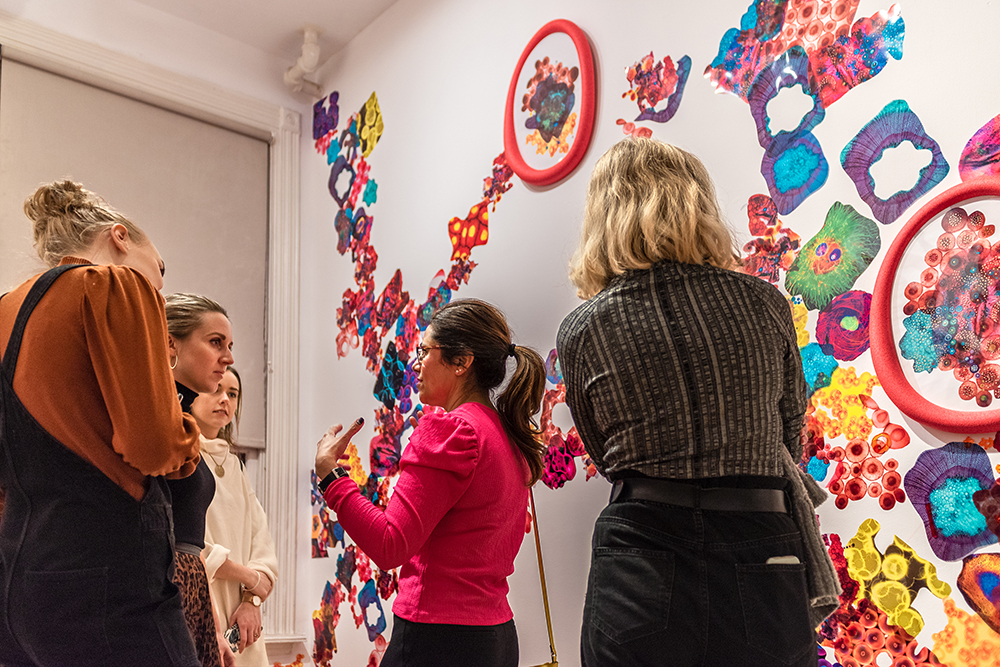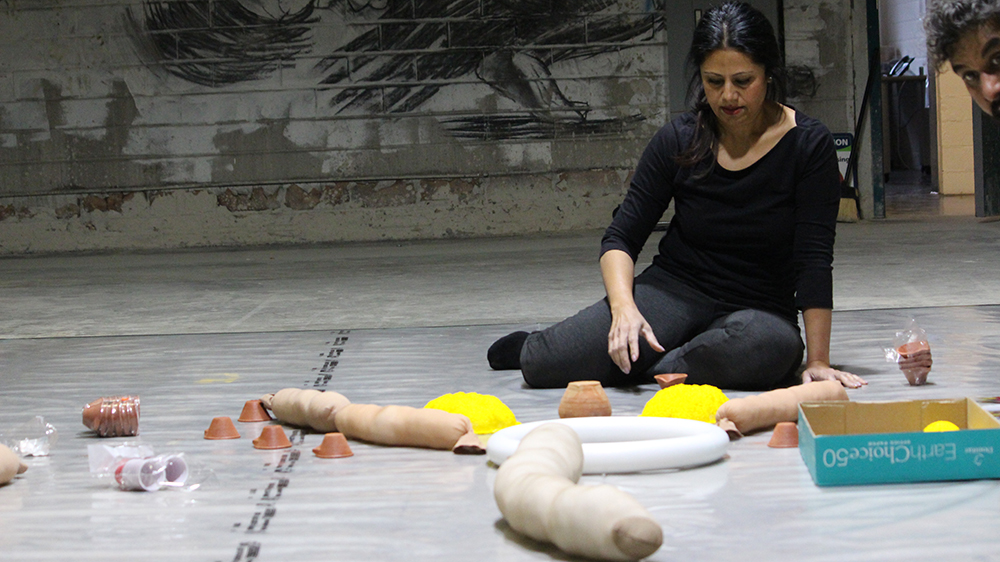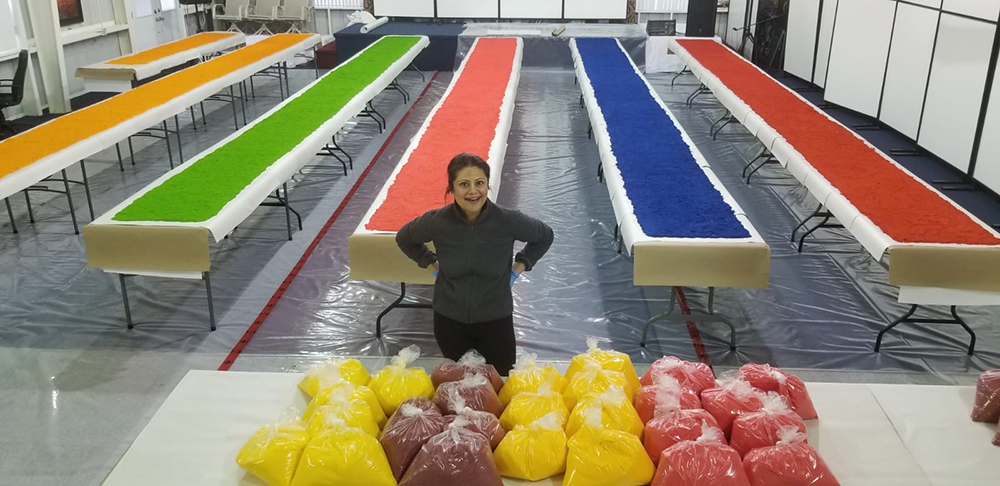Round Table: The course of creativity
design ideas and the environments that nurture them
MODERATED by Scott Torrance, OALA
BIOS/
Noni Kaur is an award-winning multidisciplinary artist and educator. Kaur’s works are an embodiment of her response to intersectional identity across cultures and communities. Her immersive, reactive, multi-sensory installations bridge gaps between gender, culture, the body, and the non-human world. Kaur’s work has been featured in international venues including: the Havana Biennale, Cuba; the Asian Art Biennale, Dhaka, Bangladesh; the Fukuoka Triennale, Asian Art Museum, Japan; White Columns, New York; the Henie Onstad Kunstenter, Oslo, Norway, amongst others. Kaur lives and works in Toronto, and was the recipient of the OALA/Ground Award at the 2019 GrowOp exhibit at the Gladstone Hotel.
Brian Porter is an Indigenous architect from the Oneida Nation. He has been working Six Nations Reserve for the past 24 years where he has been the principal of Two Row Architect, a solely aboriginally owned and operated architecture firm. Brian has worked all over Canada, the United States, and many different First Nation Reserves.
Deanne Mighton is a passionate and dedicated urban designer at the City of Toronto who has worked with a variety of stakeholders both private and public to ensure changes to our urban landscape are innovative, transparent, and well integrated into the existing context, and contribute to a progressive vision for the city’s future. Dedicated to a philosophy of compact urban form, transit-supportive communities, active transportation, sustainable built form and infrastructure, and the conservation of the city’s existing character and heritage. She works to balance and shape a variety of competing interests in the urban landscape to achieve a cohesive whole.
Matt Perotto worked as an Associate at Hargreaves Jones Landscape Architecture in their San Francisco office before moving back to Toronto this past summer and now works with Hargreaves Jones as a collaborator on projects throughout the United States and China. While in San Francisco, he taught at the Academy of Art University’s School of Landscape Architecture and is now a Sessional Lecturer at the University of Toronto Daniels Faculty of Architecture, Landscape, and Design in the Graduate Landscape Architecture program.
Adrian Blackwell’s practice responds to the political and economic forces inscribed in physical spaces, spanning photography, video, sculpture, urban theory, and design. His work consists of interventions that address the powers and interests that shape contemporary cities, alongside research focused on the local and global effects of neoliberal urbanization.
Carol Phillips is a Partner with the renowned architecture firm Moriyama & Teshima Architects known for remarkable, innovative Canadian and International projects. Carol is Design Leader for many of the firm’s most valued projects. A graduate from the University of Waterloo School of Architecture, Carol gained experience in Spain, Western Canada, and Hong Kong prior to settling in Toronto. The majority of her award winning work is in Ontario; such projects as the Visitor Welcome Centre in Ottawa, the Multifaith Centre at U of T, and the Arbour have been published extensively. Carol lectures and supports the schools of architecture and design in Toronto as a guest critic and lecturer and has been A keynote speaker at schools as well as professional conferences.
Scott Torrance, OALA, CSLA, ASLA, is the Senior Director of Landscape Architecture at FORREC where his passion is to connect people to nature with his work. He lives in Toronto with his wife and three children and is an aspiring jazz guitarist, composer, and performer.

Scott Torrance: We’re talking about flow and creativity. It’s a mysterious topic. Some put the first idea they have on paper and move on, so it’s out of their head and into reality. Others want to gather all the information they can, sleep on it, and let their subconscious mind sort things out. The first question is what hobbies or activities do you use to support your creative process, relative to your profession? Things you do that are complementary to your day job.
Adrian Blackwell: Going to a demonstration like I did against the Prospectors and Developers of Canada Association. I find the collective action of people very inspiring as a way to think creatively. I think creativity is about change in a political way, so activism is inspiring to me.
Deanne Mighton: My husband and I have a renovation problem we’re regularly working and playing with. Also, I love gardening. So when I look at the landscapes’ details, I’m actually interested, mostly, to steal them for myself.
Brian Porter: I also had yard work down as a great love of mine. I’ve got about six acres that I look after on three separate sites. So I have an opportunity to plant trees, cut down and cull them, garden, and cut grass—chances to let some place naturalize. I get a lot of joy out of being responsible for that. And when everything you’re working on feels like it’s long term, it’s nice to be able to invest a couple hours and see what you accomplished and feel like a steward.
Matt Perotto: When I’m trying to get the creative juices flowing, I like to explore ideas with sketching, whether I’m working at my desk or sitting in front of the TV. Creative ideas sometimes happen even while sleeping and dreaming, as funny as that sounds. But, in contrast to staying focused on working, I take breaks by playing music, I have an electric drum set at my house, and I play sports like hockey. In fact, I have a playoff game tonight.
Noni Kaur: I’m really into growth and decay. And my thing now is to watch mold and moss and plants decaying, or things like food going rancid. That really gets my juices flowing. So anything from different environments: taking walks in the bush or trails, feeling the sand, and just things falling apart.

Carol Phillips: As it directly relates to my work, what gives me a lot of inspiration for architecture are the immersive experiences I get from traveling or camping, where I’m in an environment that is often unfamiliar. I always come back from backcountry camping or traveling to a different city with a heightened awareness of how place and the land impacts how you behave. On a domestic level, in my little urban patch of land, my husband and I have been planting as many trees as possible. In an urban environment, the garden is sensitive to light change as the trees grow and it is a lesson in relinquishing control observing how nature responds.
ST: Do you have a specific creative process that you work through when you’re at your office or home studio to create the kind of work that you do?
CP: I like to cook, without following recipes. Taking the raw ingredients or raw material of any project and trying to understand what’s possible. I try to understand what we’re dealing with—whether it’s the land, culture, urban environment, or even the constraints of a project—and trust the process of sketching and designing, what emerges off the paper, and let that information saturate the process. It’s about trying to create something genuine out of the material that we have. I dive into the material we have in front of us as a project and see what works.
ST: Deanne, what do you find most challenging in terms of keeping that creative spark lit?

DM: I work in a very bureaucratic system. So I find the emphasis on planning policy over the quality of built form and landscapes frustrating sometimes. There’s an attitude that those are details to be worked out, but we really work on a design before we figure out if it’s supportable or not. I like seeing connections between projects. I often try to point people to different examples of things done right, or where we can take an aspect and improve on it. And the best part is having collaborative meetings and being able to have free discussion about design, versus “does this fit policy X, Y, or Z?”
ST: Brian, you graduated in the ‘80s, you’ve had a practice for quite a number of years, how do you keep getting out of bed and being excited about what you do?
BP: The development experience for a lot of our clients is quite varied. We’re working for some where it might be the first capital project they’ve ever been involved with. For others, they’re seasoned veterans and they’ve been at it for a while. So we get a wide range. With the seasoned veterans, they’re often challenging us to be better, more technically sound, and to work towards things like net zero carbon emissions and LEED goals. And others are naive, but filled with enthusiasm you feel through osmosis. I bounce between those types of clients, sometimes on a daily basis. It’s hard not to feel some of that energy, to keep going, and try to make yourself better. I don’t really work, I just play all day. I tell people I’ve never worked a day in my life. That’s part of keeping things fresh: being happy with what you do.

ST: Adrian, do you believe you can create space, or plan for creativity on demand, or do you feel that it’s something which happens naturally or spontaneously?
AB: I think creativity often comes in response to specific problems. Necessity produces inventions. And so, when we’re confronted and we have to act, it provokes us to create new things. That’s the immediate inspiration for creativity. But we also need space and time. We need to carve that out of our schedules or practices in different ways. I think I was most creative in an early stage in my career, when I had a lot of time and fewer pressures. There are ways of organizing your life so things open up again, and you can be more creative. But this duality also makes me think about the luxury of creativity. It’s something which is often thought of as class-defined: that people who are wealthy enough that they’re not worried about basic necessities can afford to indulge in creativity. But I also think the opposite is true. The most inventive people don’t have those means, and are forced to solve problems. That may not always be held up as creativity, but it’s where the real creative work is done. Creativity is a kind of confrontation. To create real change, you need problems that provoke that change. But, whatever situation you’re in, you have to find a little bit of space to create.

ST: For those of you who teach, how does that inform or add to your creativity? Does it augment, or take away some of your creative energy because you’re giving it out?
MP: I enjoy teaching a lot. It allows me, in my own work, to rewind and get back to basics. I’ve always taught visual communication, but I’ve reworked the pedagogy in those specific courses to be a lot more about design process, rather than just the software. It’s almost therapeutic, in a sense, to get back to the raw, simplified process of working through some of the tools we use in the early phases of inventory analysis, all the way through to 3D modelling and visualization. I also find, in working with students, sometimes they bring up or question the process or the way we move through designing. Sometimes, those ensuing discussions have translated back into my concurrent work in the office.
NK: I teach a course in studio practice where we get to play. I’m learning as much from students as they’re learning from me. It becomes a two-way conversation. And that really informs me in my practice. It reflects the ideas I would then put into my daily work and research.

AB: I really love the relationship between theory and practice I get in the kind of teaching I do. I guess that’s how I drifted away from practice: I wanted to be in a space where I was being intellectually challenged on a daily basis.
ST: Most projects have constraints: budgets, timelines, clients, physical space, codes. How do you deal with constraints and how does it affect your creativity?
NK: My work is ephemeral. It’s about decay, and I work with materials that are constantly breaking down. So I can be a nightmare for galleries and museums. As an artist, I think that’s always the biggest challenge, as well as working in situ. I go to the space and work on the spot (it’s all site specific), and I get curveballs from different directions. Anything from the lighting, to cracks in the floor that everything is just going to fall through. Or, because the work itself is a living piece, it’s going to create stains, and there are going to be bugs and bacteria that could go through the vents and into permanent collections. I’ve had these challenges and I think I thrive on that. That’s my rush. That is why I always go bigger and more complex. As for budgets, as artists, we live on grants most of the time. So, depending on the space and the organization, that would also dictate how big or ambitious I can get.
CP: A lot of what we do is ultimately problem solving, which doesn’t really sound like creativity, but I don’t separate the two. Especially now, the world has such gigantic problems to solve that I think, if we can’t approach them with creativity, we have no chance of living gracefully with each other, or the planet. So I embrace constraints. And sometimes, in our process, they are incredibly oppressive. I’ve been involved in design-build projects where there are incredible timelines, huge restrictions and demands that have to be met, and if you don’t meet them you’re disqualified. But we get more creative when we have these almost impossible tasks. Oftentimes, I find some of our best work comes out of projects that have the most constraints. Sometimes too much freedom is overrated in the creative process.
MP: That gets back to something Adrian said earlier about necessity producing invention. One of my first projects was a design-build with 18 buildings. We had a great concept for the landscape, but working with multiple architects, each with their own elements to work through, meant footprints continue to shift, and thus the landscape required continued revision. We came to a point where a creative solution to mitigate these challenges was needed and we decided to just let code and requirements for circulation around buildings dictate how the landscape looks. Grade change became formalized landforms and code setbacks were articulated in their geometry. I think there’s always a creative way to generate new, divergent ideas, born from what the restrictions may be.
DM: I wholeheartedly believe limitations are good for the process, if they’re done in a transparent way that identifies the constraints, and show the design solutions and the trade-offs to the client, as well as the stakeholders.
BP: I usually talk about bead work when I think about limitations. What I like best about bead work is that glass beads are very cheap, abundant, and accessible. They get their value by the way they’re put together and arranged to make different patterns. It’s something anybody can do if they want. I don’t really like architecture that has solutions that aren’t accessible, or easily replicated—where the technology has got so tight and expensive that it doesn’t travel well. I prefer architecture made up of components that are affordable and make more sense, maybe they’re harvested locally, and they get their value from how they’re put together. I’m more interested in that than in exclusive solutions that can’t happen without star architects shining a flashlight in a dark room.

CP: Sometimes the inventiveness is not even in the result, it’s in the process. I recall one example, working on a museum competition. There was a lot to learn and a large time constraint, so we decided a key problem at hand was how to fast track our understanding of the museum’s World War II focus. We brought a historian onto our team to teach us. We sat in a room and had them lecture us about the place and subject matter of this project for two solid days. Without the time constraint, we might not have brought this person into our process, but it generated so much creativity out of the team. Having people outside of architecture come and inform the process is amazing.
BP: We had a client that wanted to invest in fairly high-tech medical imaging, and create this centre for sports medicine and rehabilitation. They asked us to put together some preliminary plans and renderings they could use to convey their idea, but they didn’t have a site yet. And I was really surprised that we couldn’t do it without having some idea about where the sun rose and set, where the prevailing wind was, whether there were any natural watercourses. I couldn’t even get started. I know what the technical requirements are. There was an idea about it being spa-like, so there would potentially be some longterm accommodations. But without having the constraints, we didn’t get very far with it, and it ended up falling off the table.
DM: Opposite of Tim Hortons, who just pulls the thing from the drawer and says ‘This is Plan F. Deal with it.’
ST: Well, that’s interesting. That’s one type of client, with a very prescriptive kind of approach, but is there an ideal client?
DM: Someone who wants to make something of the place. As long as they’re open to having that conversation, including with stakeholders, neighbours, and area experts. When someone says they’re going to plunk down something generic, it never really goes well.
MP: I’d say no, but it’s always nice to have a client that knows what their comprehensive goals are at the start of a project so that nothing new comes up which requires backstepping to reconceptualize the design; and if they know the internal and external stakeholders who are going to play a role, they provide that information upfront, so we can work with them from the beginning to avoid surprises later.
NK: I don’t think there’s an ideal. I love the challenge. Being on your game all the time sparks the creative process, because then you problem solve. I think artists have to be on the edge all the time. If it’s too textbook, then you don’t evolve, the practice becomes almost stagnant.
CP: If there’s a participatory attitude from the client, one who understands that they play a role, and brings their own accountability to the table to help to make decisions and solve problems, that’s part of the ideal process. I don’t necessarily mean design-by-consensus. What I mean is: in order to enable a complex project, you need a lot of people to understand how to work through that complexity and find a common goal. An ideal client for me, in that context, is a participatory one.
ST: How do you foster creative culture in your workplace with others?
MP: In our office, we foster an environment where everyone feels like a friend. It provides a level of comfort, especially with newer, junior designers who are just joining the team. And that translates back into the work setting, where everyone feels comfortable to participate in the design process. The other half is technology: we’re really open to using new technology for designing and collaborating. It pushes the boundaries for what and how we create.
DM: City building’s a team sport. Good ideas are good ideas and they should be credited. I try, wherever I see them, to encourage and uplift them. (And will steal them from wherever).
ST: Carol, you’re the principal in your firm. Is it top-down, or is it a true team process?
CP: It’s a combination of trusting your individual passion, but also listening, learning, and working with the people around you. I try to be genuine, in terms of seeking the essence of a project, and then guiding the process based on the integrity of the ideas and how they’re resonating with the project team. It’s about conducting, rather than just playing every instrument. But you do need someone there to help recognize what’s emerging from the noise.
BP: We strive to get our organizational structures as horizontal as we can. Sometimes that’s hard to do with institutions that are used to a more corporate organization. But one of the things we like to do with our projects is gaming exercises, where small groups create three-dimensional representations. A lot of times, we’ll purposefully engineer the groups a little bit. We were doing a branch designed for an SPCA facility, and put board members with day-to-day staff, or staff with volunteers. We’d give them game pieces, stand back and watch them interact. A lot of them had never met each other, so to be able to see what each of them was bringing to the table, what their priorities and roles were within the organization was really interesting. We photograph all the solutions, and our job is to distill the best ideas, take the pieces we like best, and put them into the final product. It’s usually pretty successful, because each of those team members can see a little bit of themselves in that solution. It’s empowering to them, but they also see how other people bring their own priorities to the table. These participatory gaming exercises—having people participate in what the solution is—demystifies the architectural process.
Thanks to Nadja Pausch for coordinating this round table.
